
The Caridea, commonly known as caridean shrimp or true shrimp, from the Greek word καρίς, καρίδος, are an infraorder of shrimp within the order Decapoda. This infraorder contains all species of true shrimp. They are found widely around the world in both fresh and salt water. Many other animals with similar names – such as the mud shrimp of Axiidea and the boxer shrimp of Stenopodidea – are not true shrimp, but many have evolved features similar to true shrimp.

Caridina is a genus of freshwater atyid shrimp. They are widely found in tropical or subtropical water in Asia, Oceania and Africa. They are filter-feeders and omnivorous scavengers. They range from 0.9 to 9.8 mm to 1.2–7.4 mm in carapace length.
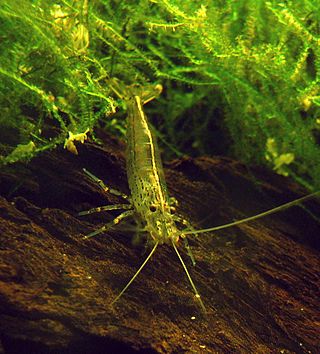
Atyidae is a family of shrimp, present in all tropical and most temperate waters of the world. Adults of this family are almost always confined to fresh water. This is the only family in the superfamily Atyoidea.

Halocaridina rubra, the Hawaiian red shrimp or volcano shrimp is a small red shrimp of the family Atyidae, with the common Hawaiian name ʻōpaeʻula.

Lake Towuti is a lake in East Luwu Regency, South Sulawesi province, Indonesia. Surrounded by mountains, it is the largest lake of the island of Sulawesi and one of the five lakes of the Malili Lake system. The Larona River flows from the lake to the Boni Bay. The town Laronda is located on its shore.
Syncaris pasadenae is an extinct species of freshwater shrimp in the family Atyidae.

Troglocaris anophthalmus is a species of freshwater shrimp in the family Atyidae. It lives in karstic caves in Bosnia and Herzegovina, Croatia, Italy and Slovenia. Although morphologically similar across its 500-kilometre (310 mi) range, molecular phylogenetics suggests that there are four or five cryptic lineages with more restricted ranges, although one such lineage does range unusually widely for a troglobite – over 300 kilometres (190 mi).

Typhlatya is a genus of shrimp in the family Atyidae. These are small, stygobitic shrimp found in the West Mediterranean region, Caribbean region, Ascension Island and the Galápagos, although the individual species often have very small ranges. Species in this genus are found in salt, brackish and fresh waters, mostly in anchialine habitats and none in the open sea.
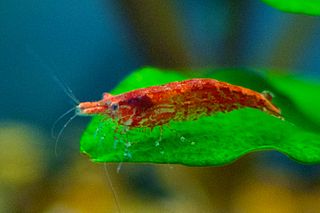
Neocaridina davidi is a freshwater shrimp originating from eastern China and northern Taiwan and introduced in the rest of Taiwan, Japan, and Hawaii, which is commonly kept in aquaria. The natural coloration of the shrimp is green-brown, though a wide variety of color morphs exist, including red, yellow, orange, green, blue, violet and black shrimp. Full-grown shrimp reach about 4 centimetres (1.6 in) long. N. davidi shrimp are omnivores that may live 1–2 years. These shrimps have previously been classified as Neocaridina heteropoda and Neocaridina denticulata sinensis, however are now known as Neocaridina davidi which is based on the oldest known published description of the species.

Stygiocaris is a genus of shrimp from caves in the North West Cape and Barrow Island, Western Australia.

Lysmata is a genus of shrimp in the infraorder Caridea, the caridean shrimp. The genus belongs to the family Lysmatidae. Lysmata are popular ornamental shrimp in the marine aquarium trade for their bright color patterns, interesting behaviors, and ability to control certain aquarium pests such as sea anemones of the genus Aiptasia. They are known to command high prices on the pet market.
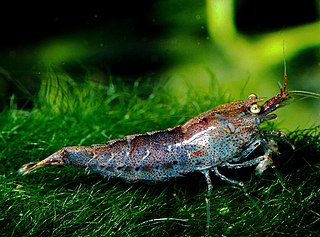
Neocaridina is a genus of atyid shrimp, containing 26 species as of March 2023. Members of the genus are distributed across East Asia including China, Korea, Japan, and Taiwan. Like many other Atyid shrimps, they live in freshwater habitats.
Birulia is a genus of shrimp in the family Thoridae. It was formerly considered to be part of the family Hippolytidae.

Lake Dissoni, also known as Lake Soden, is a small lake in the volcanic chain in the Southwest Region of Cameroon. This volcanic lake has diameter of about 1.25 km (0.78 mi) and is at the southeastern foot of the Rumpi Hills.
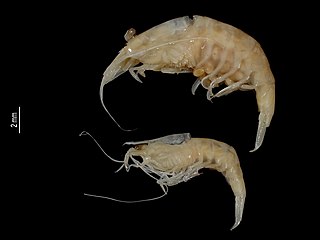
Caridina linduensis is a species of freshwater shrimp in the family Atyidae, endemic to Lake Lindu and its effluent stream in Sulawesi. It was known only from the type series, collected in 1904, and was recorded again in 2011 in a survey around Lake Lindu and is found in shallow littoral habitats of leaf litter, macrophytes, and dead wood. In the effluent stream it is found on soft substrates and slow flowing water, and is less common in the lake itself. The type locality of Lake Lindu was designated as a Recreation Park in 1978, and is part of the larger Lore Lindu National Park and UNESCO Biosphere Reserve. It is listed under IUCN criterion B1ab(iii,v) as Critically Endangered due to threats from introduced species of fish, land conversion to agriculture, logging, and shore disturbance caused by the grazing of water buffalo. Surveys are required to find the full distribution of C. linduensis, primarily its habitat in the effluent stream. C. linduensis is also sympatric with the recently described species Caridina dali and Caridina kaili.
Procaris noelensis is a species of shrimp, a single specimen having been described by Bruce & Davie from a freshwater/tidally influenced cave system on Christmas Island in 2006.

Periclimenes, commonly known as glass shrimp or cleaner shrimp, is a commensal and often symbiotic genus of semi-transparent shrimp within the family Palaemonidae. Species of this large genus feature a wide variety of coloration and patterns, widespread distribution throughout much of the world's tropical oceans, and are often sought out for aquarium trade.
Iazoni Cave Natural Monument also known as Tskaltsitela Cave is a karst cave located across the river Tskaltsitela near village Godogni, Terjola Municipality, just outside Kutaisi in Imereti region of Georgia, 135 metres above sea level. Cave is on the right bank of Tskaltsitela river, the tributary of the Rioni, near Godogni village bridge.
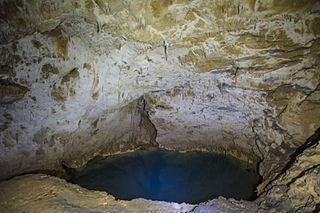
Motena Cave Natural Monument is a karst cave located 0.7 km to the south from village First Balda in Martvili Municipality in Samegrelo-Zemo Svaneti region of Georgia, 437 meters above sea level. Cave is located on left bank of Abasha river. In Middle Ages Motena cave was integral part of the now lost fortress.















